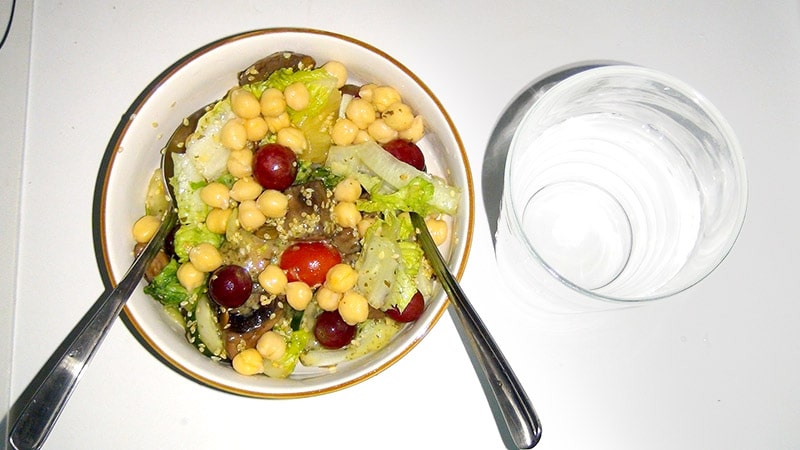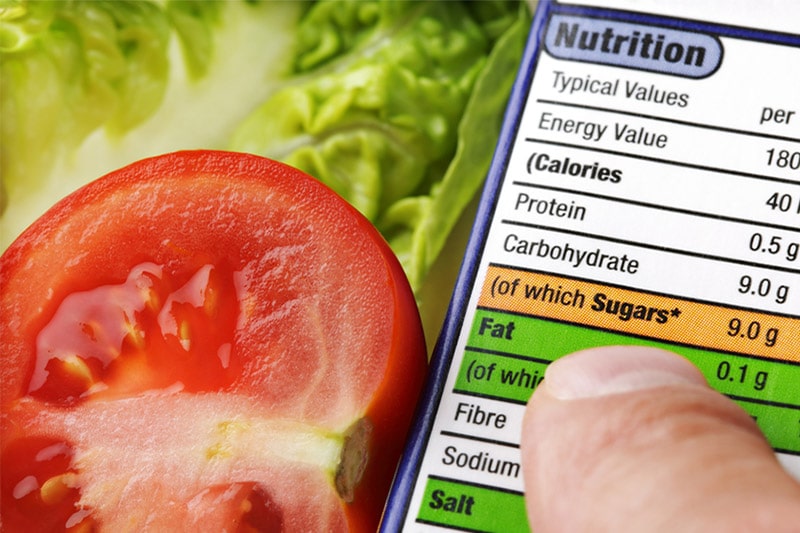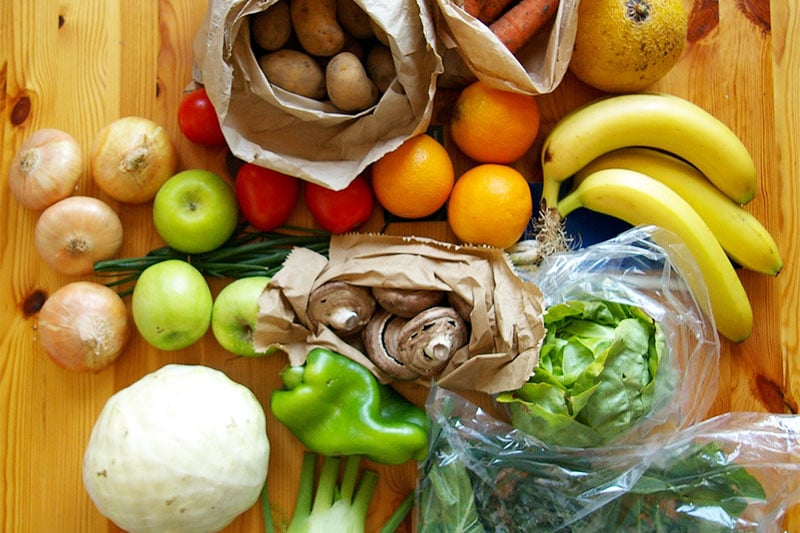This is the last part of a 6-part series on emotional eating: how I used to be a severe emotional eater, how I overcame my stress eating issues, and how you can stop stress eating, starting today.
- Part 1: How I Overcame Emotional Eating, Part 1: Food as a Symbol of Love
- Part 2: How I Overcame Emotional Eating, Part 2: Deep Entanglement
- Part 3: How I Overcame Emotional Eating, Part 3: Becoming at Peace with Food
- Part 4: 12 Signs of Emotional Eating (And Why It is Bad For You)
- Part 5: How To Stop Emotional Eating, Part 1: Tackling the Causes of Emotional Eating
- Part 6: How To Stop Emotional Eating, Part 2: Rebuilding a Healthy Relationship with Food

One of my usual home-made salads
This is the last part of a 2-part guide on how to stop emotional eating. Read Part 1 first if you haven’t, which is on how to tackle the causes of emotional eating. Today’s article is Part 2, on how to (re)build your healthy relationship with food.
How to Stop Emotional Eating, Part 2: Building a Healthy Relationship with Food
1. Stop eating based on unrelated factors (Eat based on your needs)
What do you base your eating decisions on? On the needs of your body? Or on extrinsic cues, totally unrelated to our body’s needs?
A lot of us eat based on factors unrelated to our body’s needs. For example, eating because…
- … our friends ask us to.
- … others have prepared food for us.
- … there is food before us.
- … we are in a restaurant and we need to order something.
- … there is still food on the plate and we should finish what we’re given.
- … we are at a buffet and we want to get our money’s worth.
- … it’s supposedly breakfast / lunch / dinner time, even though we are not hungry.
- … we don’t want to waste food.
- … we have cravings (that are unrelated to hunger).
- … the food advertisement looks tempting.
- … we are sad/happy/bored/stressed/depressed (emotional eating).
In reality, these should not play any role in our eating decisions, because they are irrelevant to why we eat in the first place – to fuel our body. Eat because your body needs it, not because you think or feel you should eat. (If you are not able to get a handle on your eating habits, read the first part of the guide on how to overcome triggers of emotional eating.)
So how do we know when and how much to eat? There are 3 reference points I use:
Reference #1. Hunger Cues
Unless your sense of hunger has been highly distorted from bingeing or crash dieting (if you’re fasting, your digestive system takes a slumber about Day 4-5 into the fast), our body does a pretty good job of alerting us when we need food.
How does the sensation of hunger feel like? It’s a slightly warm, acidic, empty, and at times, gurgling sensation in your stomach. To know what I’m referring to, put off eating after you wake up tomorrow. Get on with your daily to-dos. After about 30 minutes to 2.5 hours, you should feel this sensation. That’s the cue to eat.
If you’re unclear whether it’s a real sensation or if you’re imagining it, wait a while more. The sensation should become more apparent the longer you wait. (Beyond a certain point, it will disappear as your body will think you don’t want to feed it. It then switches to getting energy from its reserves. This doesn’t happen till after 20-30 minutes though.)
(For those who read the Fasting Experiment, this hunger cue is not the same as true hunger, where you feel a strong call for food from your throat as you enter starvation mode. This is a call from your stomach to feed it so it can get energy for the day.)
Since addressing my emotional eating issues, I’ve cultivated the habit of eating only when I feel hunger. And I eat until I’m about halfway full. If I eat too much, not only do I feel uncomfortable and sluggish, I lose touch with my sense of hunger, which then throws my eating off balance for the day.
Drawbacks of Relying on Hunger Cues
While using hunger as an indicator is great for the most part, it is not sufficient.
Firstly, it can be ambiguous for those who do not have a good grip on their diet, be it from constant overeating or undereating in the past. For the emotional eaters, they may be unable to distinguish a hunger cue from an emotional eating trigger. Their stomachs may also call out for food even after they have met their calorie needs for the day, because they have been accustomed to eating large quantities of food. For the undereaters, their stomachs may not call out for food the entire day, because it has accustomed to getting little to no food.
Secondly, it may not be very accurate, as some food are filling yet low in calories (salads and some fruits), while some food can be non-filling yet high in calories (nuts, desserts). You can consume salads, feel full for the entire day, yet consume 500-600 calories only. On the other hand, you can eat a truckload of junk food and still be hungry, because of its addictive and non-filling nature.
This then leaves us to our second reference point.
Reference #2: Caloric Needs
Some people swear by calorie counting. Some people think it’s redundant.
Me? I believe in tracking calories, because it is the only way you can know with certainty whether you have met your energy needs for the day.
Sure it may be troublesome, but it’s not as bad as you think. After 1-2 weeks of tracking, you should have a good idea of how much you need to eat to meet your needs. You would also know the calories of most food by heart, especially since most of us end up eating the same items every day anyway, by habit and preference.
For me, after extensive calorie tracking in the past, I know the calories of most food I eat by heart. I also know roughly how much to eat to match my needs daily. At the same time, I make a point to do a quick mental tabulation of my calorie intake 1-2 times a day to ensure I’m not eating too little/too much.
Limitations of Relying on Calorie Counting
Calorie counting is great, but at the end of the day it is only 1 metric. It can tell me whether I’ve met my overall energy needs, but not if I’m meeting my nutritional needs. One can consume all calories from junk food, match his/her calorie intake every day, and still be in poor health due to the poor quality of food he/she is taking.
For this, we would need another metric.
Reference #3: Nutritional Needs

The last reference point is our nutritional needs. I see 4 essential components of nutrition: (a) consuming right calories from carbohydrates, protein and fats (b) getting sufficient vitamin and minerals (c) getting sufficient fiber intake (d) taking in high quality of food.
As to the exact definition of what a nutritious meal is, it differs from person to person, since it’s a function of our beliefs and values. Instead of dictating what you should consume, I’ll instead invite you to educate yourself on food, nutrition and health (see Step #6), so you can make the decision yourself.
Applying All 3 Factors
So putting it altogether, what I do is I (a) eat only when I experience hunger cues, stop when I fill full or have consumed sufficient calories for that meal (b) ensure I consume the right calories every day (c) ensure everything I take in fill my nutrition needs. These 3 factors are immensely useful in helping me stay true to my ideal diet every day.
2. Detach Your Emotions From Food
A lot of us attach emotions with eating and food. We use emotionally charged words to describe food, such as “sinful”, “decadent”, “guilt-ridden”, “love”, “lust”, “indulgent”, “enticing”, “craving”, “tempting”. We long for and even become deeply fascinated with food, even though food is a non-living thing, incapable of feelings nor returning our love/affection.
A truly healthy relationship with food is one where you see food as exactly what it is supposed to be – something you consume to fuel your body. That’s it. Nothing more, nothing less. It’s a completely neutral relationship, one with no attachments, no inclinations, no push-pull / attraction-resistance going on.
Enjoy food while we eat, appreciate how it is made, and feel blessed for having food in our lives, but don’t make it out into something it is not. At the end of the day, food should be a neutral object in your life, just like eating should be a neutral activity, like breathing and passing waste.
3. Take Ownership of Your Diet
Do you often slip off your ideal diet? Do you eat when others invite you to, even though you are not hungry? Do you continue eating even when you are full, because you feel you should finish what’s on the plate?
If you do, you’re not alone. Looking back, I often compromised on my ideal diet, based on the situation I was in.
If I was in a restaurant, I would order the mains even though I wasn’t very hungry, because I thought I should match what others were ordering. I would then blame my misstep on the fact that I was eating out. If there was food in the house, I would eat that, then blame my overeating on the food. If there was junk food, I would eat that, then blame my poor diet on lack of availability of healthy food. If someone offered me food, I would take it, then blame the circumstance for making me slip on my diet.
Of course, I was the reason why I kept slipping off my ideal diet – not the food, not the restaurants, not other people, and certainly not the situations. I had given power of deciding what to feed my body over to others. It was when I took ownership of my meals that I turned that around.
Similarly, take ownership of your meals. The power to decide what to feed your body lies in you. Don’t give this power away to the situation, the people, or even food itself. The power to decide what to feed your body lies in you.
Follow these tips:
- Know your ideal diet, and stick to that. See Step #7: Nourish Your Body with the Highest Diet.
- Do your grocery shopping. Don’t rely on others to buy food for you.
- Pack your food/meals if you want to be in full control of your diet. (A++!)
- Buy only what you need. When at the grocer/restaurant, buy only what you want and what you will finish. Don’t buy more than you need.
- Sides over mains. Order sides over mains in a restaurant if you’re not very hungry. Don’t order anything if you’re not hungry at all.
- Don’t order just to compromise. If the restaurant does not have what you want, (a) check out other places (b) order takeout from another place so you can still dine with your friends (c) don’t order anything.
- Stop eating when you had your fill (whether because you are halfway full or because you met your caloric needs for the meal/day). Doesn’t matter if the food is 80% untouched, or if there is only 1 string bean left. Doesn’t matter if you have not touched your drink or if there’s only 1 drop left. Put your food away if you’re at home. Ask it to be packed if you’re in a restaurant. Offer it to a friend if you want to. Throw it away if no options are plausible. Simply stop eating.
- Say no to food offers when you are not hungry. Eat because you need to, not because you feel obligated to. People may offer food to express intentions of love/kindness/friendship, but even then actions are actions, not intentions – they are merely a medium to convey their intentions. Accept the intention, but say no to the action if you do not need to eat. You are definitely not being rude, and there’s no reason for the person to take it that way too.
4. Practice Conscious Eating

Unconscious eating is a norm in our society today. We eat with zero awareness of our food. Because of that, we don’t know we are full until we have eaten way more than we should. This makes us numb to the sensations in our stomach, which then results in erratic eating habits thereafter, because we confuse emotional eating triggers with hunger cues. (see #1).
I was no different. In the past, I could eat a whole bunch of food and feel like I had not eaten anything, because I was eating unconsciously. I had chewed and consumed the food, but mentally it didn’t register.
On the other hand, the first few meals after my 21-day fast were some of the most conscious meals I had up until then. The sight, the smell, the taste, the texture – I experienced my food on so many levels deeper than I normally would. It was an eye-opening experience.
Today, I make a point to eat consciously. I consider it one of my daily rituals. Here are my tips to practice conscious eating:
- Don’t mix eating with other activities. Before you eat, put everything aside, be it your laptop or mobile phone. Concentrate on eating and eating only.
- Know what you’re eating. Examine the ingredients. Look at the nutritional content. Educate yourself on what you’re feeding your body. Read Step #6: Educate Yourself on Food, Nutrition and Health.
- Before you eat, feel the sensation (of hunger) in your stomach.
- Be grateful for this food that you’re about to eat. Think about all the work that went into the creation of this food — the harvesting, the procurement, the delivery, the preparation, the cooking (if the meal was cooked), etc. Be thankful for each and every person who was involved in the creation of this food.
- Now as you eat, do so one bite at a time. With each bite, chew very slowly and deliberately. Relish the taste of food in your mouth. Feel the texture.
- As you eat, do so one bite at a time. With each bite, chew very slowly and deliberately. Relish the taste of food in your mouth. Feel the texture.
- At the same time, be aware of how your stomach feels. Feel the sensation of hunger fade away slowly with each bite. Feel your stomach being filled up as you eat.
- Then, stop when you feel halfway full or you have consumed enough calories for the meal.
Practicing conscious eating will help you to (a) be more in tune with your hunger cues, so you don’t overeat unconsciously (b) be more conscious of the role of eating / food in your life, which supports you in building a healthy relationship with food.
Even if you’re eating with friend(s), you can still eat consciously. Don’t chew and talk at the same time. Every time you take a bite, focus your attention on your food, and concentrate on chewing, savoring the taste, and digesting the food. When you are done with the bite, put your attention back to your friend(s). Listen to what he/she has to say. Say what you want to say. Do that in turns and you’ll be fine.
5. Avoid Addictive Food
To stay in tune with your hunger cues, avoid addictive food. Not only do they mess up your sense of hunger, they are also highly disgusting. I’m referring to (a) junk food / fast food, like soda, fries, burgers, candy bars, chips, cake, etc (b) highly processed food, like canned food, pre-made meals, crackers, etc (c) food with a high level of sugar, salt, MSG, and/or artificial ingredients like flavors, sweeteners and preservatives.
How does addictive food work? It stimulates your mouth and alters your brain activity, driving you to eat even though you may have had your fill. A recent study showed junk food consumption can be as addictive as heroin or cigarettes:
Scientists have found that a “café-style” diet of fatty, sugary food results in compulsive overeating among rats and causes neuro-chemical changes to the brain that mimic the sort of alterations in the human brain brought about by addiction to heroin and cocaine.
The findings lend support to the idea that certain types of energy-intensive foods can trigger compulsive overeating and obesity in humans, leading to a form of food addiction that is almost impossible to overcome by dieting.
The researchers found that rats offered junk food quickly became so attached to it that they would endure painful but harmless electric shocks to their feet in order to eat it. They would even prefer to starve themselves rather than eat the “salad bar option” of the typical rodent food eaten by rats that had never had junk food.
When the scientists analysed the brains of the junk-food rats they found that a key pleasure-reward system known to be involved in triggering drug addiction in humans was overstimulated, causing the animals to eat more and more food in order to enjoy the same chemical “high” felt in their brains.
“It presents the most thorough and compelling evidence that drug addiction and obesity are based on the same underlying neurobiological mechanisms,” said Professor Paul Kenny at the Scripps Research Institute in Jupiter, Florida.
“The animals completely lost control over their eating behaviour, the primary hallmark of addiction. They continued to overeat even when they anticipated receiving electric shocks, highlighting just how motivated they were to consume the palatable food.”
(Source: The Independent)
If you’ve watched Super Size Me, a 2004 documentary of a guy who went on a 30-day experiment eating only McDonald’s, the guy would feel depressed when he wasn’t eating (McDonald’s), and feel happy when he was eating (McDonald’s).
Being a regular patron of fast food restaurants in the past, I experienced similar effects. I’d eat, but crave for more (fast food) after each meal, even though I was technically full. There was something about the food which kept me wanting more. The high salt content would leave my mouth very dry too.
I experienced the same thing with highly processed food, such as roasted nuts, sweetened cereal, prepacked meals, potato chips, cookies, donuts, cake, candy bar, dips, etc. No matter how much I ate, I’d still want more.
On the other hand, when I’m on a whole food diet filled with fresh, raw fruits and vegetables, I don’t experience such addictive symptoms. I eat when I need to, and I stop when I want to. Needless to say, this has helped me to maintain a healthy relationship with food.
6. Educate Yourself on Food, Health, and Nutrition

If you want to have a healthy relationship with food and your body, it’s imperative you educate yourself on food, healthy, and nutrition.
After all, how well can you be taking care of yourself if you don’t know what you’re putting into your body? If you don’t know what the food you’re taking in is doing to your body? If you don’t know what your body needs to function at its highest potential? If you don’t feed it with the best possible food you know of?
I used to be nonchalant about what I put in my body. I thought health-conscious people were crazy. Today, I have a great deal of respect for them, because it shows they care about their health, their bodies, and themselves. I think all of us should be more conscious about our health, because this is the only body we will live in this lifetime.
Take time to educate yourself. Experiment with different food and diets. There are countless things to learn on food, health, and nutrition. Every piece of information will help better your health.
7. Nourish Your Body with the Highest Diet
In line with educating yourself (see #6), feed your body with only what you deem as the highest nourishment.
Now, what one defines as the “highest diet” is relative, because everyone is different with bodies, beliefs, preferences, and values. Hence, it’s something you have to discover for yourself. Research about different foods and what make up a healthy diet. Go on 21-day trials, where you try X diet for 21 days. Try different diets to see their upsides (and downsides if any), before you make any conclusion.
While the highest diet may be different for everyone, here are some universal, healthy eating principles we can follow:
- Create your ideal meal plan. Identify your highest diet, then create your ideal meal plans. Then, follow them to a tee.
- Get rid of junk food. As stated in #5, get rid of junk / fast food, which are loaded with calories with zero nutritional value. That includes all your chocolate candy bars, conventional desserts, chips, burgers, etc. If you are on a western pattern diet, you may find it hard to do so right away. That’s okay — just start off small, and work from there.
- Choose real food vs. processed food (where you can). A lot of food today is highly processed, changed from its natural state, with a lot of artificial ingredients added. Food is no longer food. You’re just taking in a bunch of chemicals and ingredients, recombined to be called “food”.
For example, check out this Youtube Video, which shows a McDonald’s fries not breaking down even after 8 weeks — when normal food should already be breaking down after a few days.Can you imagine feeding your body with that? The fact that the food isn’t breaking down like normal food suggests it’s so processed that even bacteria does not recognize it as food anymore. Imagine how much load you put on your system whenever you feed it with processed food.
- Go for organic vs. non-organic food. As much as possible, go for organic food, which is food produced using methods that do not involve modern synthetic inputs, GM modification, and do not have chemical additives.
- Go for less sugar / unsweetened / low fat / no-fat options. Nowadays, food comes with healthier options – from reduced sugar, to no sugar, to low fat, to fat free (of course, note that just because something is low-fat or fat-free doesn’t necessarily mean it’s healthy).
- Remove caffeine from your life. Caffeine is a psychoactive stimulant drug that alters your brain function, and your body has no need for this stimulant. Even if you are an avid coffee drinker, there are plenty of decaf options nowadays. Read about the downsides of caffeine: 5 Reasons To Quit Drinking Soda Drinks (And How to Do It)
- Eat more fruits and vegetables. For your vitamins, minerals, and fiber. Get at least 5 servings a day, of different colors (the colors represent different anti-oxidant properties).
- Use healthier food preparation methods. Go for less MSG/salt/sugar/oil – or even none if you can. Go for steamed vs. fried food. Baked vs. fried. Raw nuts vs. roasted/salted nuts. And so on.
- Drink more water. 8 glasses a day, ideally. Many of us don’t drink enough water daily, which dehydrates our bodies. Usually signs of dehydration (dry lips, dry throat) only surface after your body has been lacking water for some time.
For more on living a healthy life, read: 45 Tips To Live a Healthier Life.
Final Words
It has been a jam packed six-part series, and I hope you have found it useful. I’ve definitely written this with my heart and soul.
Even though I started writing this series after I achieved resolution in my emotional eating problem, I still managed to gain new insights about it as I was writing. It has been a very meaningful process for me, sharing my story, breaking down emotional eating into its crux, and coming up with this holistic guide to stop emotional eating. I thank you guys for being the reason and inspiration for me, always.
For those looking for a step-by-step program to walk you through overcoming emotional eating for life, I have created How to Stop Stress Eating Program, a premium course based on my highly successful emotional eating group coaching courses. While this article series shares my story of how I have dealt with emotional eating and the broadline steps to overcome it, this four-week program truly deals with the core of emotional eating and presents them in a simple, easily understandable four-part framework to help you overcome your emotional eating for life. It is truly my best solution I can offer to anyone with stress eating and emotional eating tendencies to break out of them forever and achieve a completely neutral and healthy relationship with food.
More details at the PE courses section: Personal Excellence Courses
This is the last part of a 6-part series on emotional eating: how I used to be a severe emotional eater, how I overcame my stress eating issues, and how you can stop stress eating, starting today.
- Part 1: How I Overcame Emotional Eating, Part 1: Food as a Symbol of Love
- Part 2: How I Overcame Emotional Eating, Part 2: Deep Entanglement
- Part 3: How I Overcame Emotional Eating, Part 3: Becoming at Peace with Food
- Part 4: 12 Signs of Emotional Eating (And Why It is Bad For You)
- Part 5: How To Stop Emotional Eating, Part 1: Tackling the Causes of Emotional Eating
- Part 6: How To Stop Emotional Eating, Part 2: Rebuilding a Healthy Relationship with Food
This is part of the Cultivate Good Habits Series. Check out the full series:
- 21 Days To Cultivate Life Transforming Habits
- Waking Early: 9 Reasons To Wake Up Early | 21 Tips To Wake Up Early
- Quitting Soda: 5 Reasons To Quit Drinking Soda (And How To Do It)
- Improve Your Posture: Benefits of a Good Posture (And 13 Tips to Get One)
- Be TV-Free: 10 Reasons You Should Stop Watching TV
- Being On Time: How To Be On Time
- Meditation: 10 Reasons You Should Meditate | How To Meditate in 5 Simple Steps
- Manage Emails Effectively: How To Manage Your Emails Effectively
- Run Barefoot: 10 Reasons To Run Barefoot
- Emotional Eating: How To Stop Emotional Eating (6-part series)
(Images: Calorie List, Apricot, Vegetables & Fruits)








 Thanks for reading. If you like my free articles, join my private email list and get my latest updates and articles sent right to your inbox.
Thanks for reading. If you like my free articles, join my private email list and get my latest updates and articles sent right to your inbox.